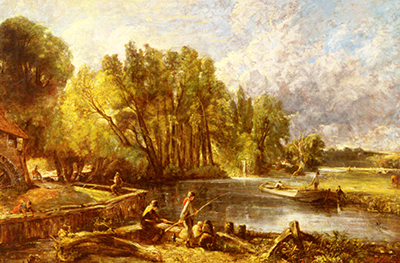Unlike most artists of his time who used to make paintings out of their imagination, Constable gave realistic depictions of the natural world. A clear description of his work can be seen in The Young Waltonians painting, which is one of his famous artworks.
John Constable, a renown English landscape painter, is remembered for his amazing pieces of artwork. Constable's paintings received great reception in France than in his home country where his painting ideas were birthed. Landscape painting involved giving descriptions of the natural scenery such as trees, rivers, and forests in a painting. The Young Waltonians is a stylised and unreal version of a countryside painting which depicts the disruption caused by the industrial and agricultural revolution.
The Young Waltonians painting, also known as the Stratford Mill painting, was created in 1820. The art had a personal and historical significance to John as it promoted the appreciation of England's scenery. The painting showed Stratford Mill on the River Stour with a barge and water meadow in the right. In this painting, John used a naturalistic brushstroke to enhance the realistic appearance of the art. Additionally, he began using light as a technique of enhancing the reality of flowing water and wind blowing through trees. John also layered reds with greens of trees to enhance the vibrancy of trees in the painting. More importantly, John applied the principle of chiaroscuro to depict the influence of light and shadow upon a landscape.
Ideally, the principle of chiaroscuro is based on the fact that the solidity of form is best achieved by the effect of light falling on it. Doing this on a piece allows the shading to give a two-dimensional figure a sense of volume. The painting was done on canvas and can be found in Room 34 of the National Gallery in London.
John had several landscape painters who inspired and nurtured his passion as a landscape painter, including Thomas Gainsborough, Claude Lorrain, and Peter Paul Rubens. Thomas Gainsborough had a love for nature, and his use of natural paintings was a great inspiration to John. Claude Lorrain, who was a master of Baroque landscape painting, was an inspiration to John. His nature of painting significantly contained human focus. Peter Paul Rubens, on the other hand, produced landscapes from his surroundings in the outskirts of Antwerp. Through his works, John also served as an inspiration to some artists from the French Romantic movement. Some of the personalities that were inspired by John include Théodore Géricault and Ferdinand Victor, who were great French Impressionists.




